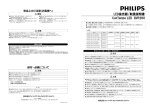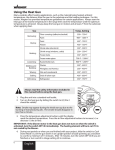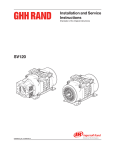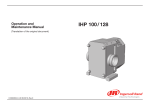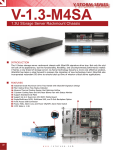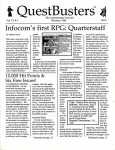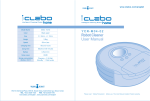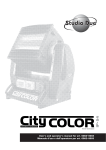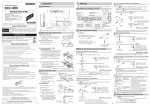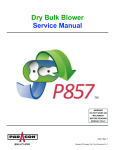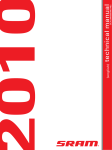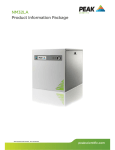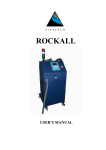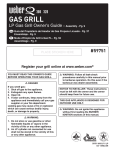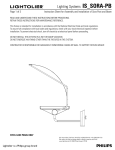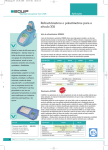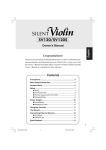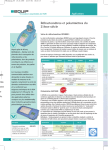Download Service Manual Part 2
Transcript
t*OTUBMMJOUBLFBJSýMUFSXJUINPVOUJOHPOUIFWFIJcle. 1 CAUTION Always insert screw head into slot on the compressor as shown. An incorrect installation can damage the compressor. NOTE 2 The intake side (the intake fitting) can be identified by the arrow marking (4) in the casing which points away from the flange on the respective side. 3 t5BLFPGGTDSFXDBQ BUUIFSVCCFSFMCPXQJFDF (3) and screw in service gage (1). t1VUSVCCFSFMCPXQJFDFPOUPUIFIPTFDPOOFDUPS fitting on the air filter casing and fasten with hose clamp. t*OTFSUBOJODMVEFEQJQFQJFDFPOUIFPUIFSTJEF of the rubber elbow piece and fasten with hose clamp. (Install pipe piece on the vehicle.) t*OTUBMMJOUBLFMJOFTQJSBMIPTF JOBOBTTUSBJHIUB line as possible on the vehicle and fasten the ends on the hose connector fitting as well as on the pipe piece using hose clamps. NOTE Keep intake hose as short as possible, shorten the hose if necessary. t*OTUBMMQSFTTVSFMJOFUPUIFUBOLXJUITBGFUZBOE non-return valve (or combined safety and nonreturn valve) and if necessary also micro filter and relieve ball valve on the vehicle in accordance with Chapter 3.5. 7 6 5 1 2 3 WARNING The length of the pressure line from the compressor to the safety valve may not exceed 1 meter. It must be ensured that it is not possible for liquids from the tank to enter the pressure line and to reach the compressor. 4 t3FNPWFGPJMBUUIFJOUBLFþBOHF PGUIFDPNpressor. Install hose connector fitting (1) and flange seal (2) with screws M10x40 (5), spring washers (6) and nuts (7) onto the compressor. 18 C23556277_EN 11/2009 Rev.0 1 5 2 3 4 4 t3FNPWF GPJM BU UIF QSFTTVSF þBOHF PG UIF compressor, attach pipe connection flange (1) of the pressure line with flange seal (2) and fasten XJUITDSFXT .¨TQSJOHXBTIFST BOE nuts (6) on the pressure flange. SV120 D kit only: The inner ring (5) in the overload coupling (1) can be taken out and inserted the other way around. A switching of the inside/outside alignment enables the installation of the following DIN and SAE flanges on the coupling: t%*/ t4"& t4"& t4DSFXJOBSUJDVMBUFETIBGUBUUIFPWFSMPBEDPVpling as well as on the power take-off flange of the vehicle. WARNING Follow the instructions in Chapter 3.3.4 for the installation of the articulated shaft. The cardan joints (1) of the articulated shaft (2) must point into the same direction. 1 1 2 3 2 5 NOTE 4 t*OTUBMMPWFSMPBEDPVQMJOHXJUITIFBSCPMUPQtional) or drive flange on the compressor drive shaft (4). Slide component over the feather key (3) on the drive shaft and secure hexagon-socket head bolt (2). C23556277_EN 11/2009 Rev.0 Provide cover plate for the articulated shaft in accordance with accident prevention regulations if necessary. 19 D NOTE 6 SV120 H kit only: 3 2 1 2 1 4 7 3 t-PPTFOTDSFXT <QJFDFT>BUUIFESJWFDPWFS (1) of the compressor and take of finger guard (3). 2 6 5 t4MJEFUIFTFDPOEIVC PGUIFþFYJCMFDPVQMJOH onto the shaft (1) of the hydraulic motor and tighten headless pin (4) into a finger-tight position. t5FOUBUJWFMZJOTUBMMUIFIZESBVMJDNPUPSXJUITDSFXT M12 (7), spring washers (6) and washers (5) on the drive cover (3) of the compressor. t.FBTVSFTQBDFCFUXFFOUIFUXPIVCT t*G UIF NFBTVSFE TQBDF CFUXFFO UIF EPFT OPU match the target value of 4 mm, move the hub(s) respectively and tighten the headless pins. 1 NOTE The two hubs should be pushed onto the shafts, approximately the same length of the way. 3 t6OTDSFXTFUTDSFX PGBIVC PGUIFþFYJCMF coupling. Slide hub over feather key (2) onto the drive shaft and fasten with headless pin; initially only tighten headless pin into a finger-tight position. 20 t6OJOTUBMM UIF IZESBVMJD NPUPS BHBJO GSPN UIF compressor covering. C23556277_EN 11/2009 Rev.0 3 4 D 2 1 5 8 7 6 t1MBDF DPVQMJOH TMFFWF POUP UIF IVC PG UIF compressor drive shaft (4) and install hydraulic motor (1) again onto the drive cover (3); at the same time push hub (5) onto the shaft of the hydraulic motor into the coupling sleeve (2). Cross-wise screw hydraulic motor with screws (8) [4xM12 or 2xM14], spring washers (7) and washers (6) into the threaded drill holes of the drive cover and tighten with the specified torque. Tightening torque: (M12 8.8): 52 Nm / 38.4 lbf ft (M14 8.8): 80 Nm / 59 lbf ft t3FJOTUBMMýOHFSHVBSEPOUPUIFESJWFDPWFS t*OTUBMMDPOOFDUJOHMJOFTPGUIFIZESBVMJDNPUPSPO the vehicle. C23556277_EN 11/2009 Rev.0 21 4 Safety labels Sticker in compliance with ANSI (North-American market) Sticker in compliance with ISO (European market) 1 2 3 4 5 6 22 Read and follow the safety notes and operating instructions before starting operation. Pressurized air outlet/direction of flow Burn hazard! Hot surface Keep out Wear hearing protection WARNING! No breathable air C23556277_EN 11/2009 Rev.0 t&YIBVTU BJS 2/B): Look for optimal position in immediate proximity to drain line and pay attention to good visibility. t)PUTVSGBDF3/C): As close as possible next to the compressor casing, the drain sound suppressor and the drain line. Do not affix directly to hot surface. t%POPUTUFQIFSF4): As close as possible to the compressor casing so that it will not used as an unintended stepping platform. t8FBSIFBSJOHQSPUFDUJPO5): Easily visible on the vehicle frame, close to the installed compressor. GB Affix maintenance information in easily visible location! Do not affix to hot surfaces! The surface must be completely free of grease and dirt! D Positioning of the stickers Position the safety and maintenance notices as follows: t3FBE0QFSBUJOH*OTUSVDUJPOT1/A): In the driver's cab right next to the control of the power take-off which starts the compressor. Maintenance information Maintenance information The operating instructions must be read prior to starting the compressor! The operating instructions must be read prior to starting the compressor! To avoid corrosion, let the compressor run for about 15 minutes after any cleaning work! To avoid corrosion, let the compressor run for about 15 minutes after any cleaning work! Clean intake filters weekly, in case of high dust level shorten the intervals between cleaning! Clean intake filters weekly, in case of high dust level shorten the intervals between cleaning! Machine no.: Machine no.: t"QQMZTFSWJDFOPUJDFJOUIFGPSUIFPQFSBUPSMPDBM language version)! t"UUBDI UIF TFDPOE NBJOUFOBODF JOTUSVDUJPO where it can be clearly seen, e. g. in the driver's cab. t&OUFSNBDIJOFOPXJUIXBUFSQSPPGQFO t/PCSFBUIBCMFBJS6/D): On each line outlet of the system where exhaust air can be extracted. t3PUBUJOHWFOUJMBUJPOQBOFME): At the plastic covers and at the aluminum drive cover (only hydraulic drive) of the compressor step. t1SFTTVSJ[FEBJSF): If possible on any feature in the pressure line behind the non-return valve. NOTE The areas that are to receive the stickers must be completely free of grease and dust! C23556277_EN 11/2009 Rev.0 23 5 Initial commissioning 5.1 General The first start of operation of the compressor kit takes place at the site of the system installer. It includes the rotation direction control and a test run with pressure test. If in exceptional cases the first start of operation is carried out by the customer, the following work has to be carried out: Work t3PUBUJPOEJSFDUJPODPOUSPM t5FTUSVO See Section 3.3.1 5.2 Rotation direction control When look onto the compressor drive shaft, the compressor step must turn corresponding to the arrow marking on the compressor casing (see Chapter 3.3.1). Compressor drive rotation speed The rotational speed range of the rotary valve compressor stated in the technical data must not be exceeded or undercut. Reliable rotational speed range of the rotary valve compressor: SV120 Min. Max. 1000 min-1/rpm 1800 min-1/rpm NOTE WARNING The further operation of the completed compressor exclusively falls under the responsibility of the operator. Ensure that the compressor is only operated within its permissible rotational speed range. WARNING 5.3 It is absolutely necessary to adhere to the operating values of the rotary valve compressor specified in Chapter 1.6 Technical data of SV120 rotary valve compressor. 5.2 Test run WARNING Prior to the test run check all safety-relevant screw connections for a tight fit. Vehicle motors with EDC control must potentially be re-parameterized prior to the start of operations. Switching Compressor Off CAUTION Do not turn compressor off if there is counter pressure! If there is counter pressure, take appropriate measures to reduce pressure before turning compressor off. CAUTION Do not turn vehicle motor off while power takeoff is running. The rotation direction, the rotational speed and the flawless function of the safety equipment must be checked during the test run. Only start compressor without any load. Never go into operation against a potentially existing counter pressure. 24 C23556277_EN 11/2009 Rev.0 Repair/service 6.1 General GHH RAND points out that damage on the seal will void the warranty. 6.2 Personnel and qualification The repair and service work on the compressor / compressor kit described in this Chapter may only be carried out by trained or educated personnel who are familiar with the applicable safety regulations. The staff of the Service Center or of GHH RAND is also available to carry out this work. 6.3 Safety Adhere to all safety instructions to prevent injuries and damage to the compressor / compressor kit. WARNING The rotor as well as the feather key groove may have sharp edges. As a prevention against injuries caused by cuts, wear protect gloves while carrying out respective work. Turn vehicle motor off prior to work relating to the dismantling / installation, remove key and secure vehicle against rolling away; use wedges. CAUTION Ensure that no foreign parts enter the compressor or remain in the compressor, because this may damage / destroy the compressor. C23556277_EN 11/2009 Rev.0 6.4 Repair time and scope If it is determined during a scheduled inspection of the separation valves (see Operating Instructions for SV120 D/H), that the separation valves must be replaced, the compressor requires repair. in addition to the separation valves, the shaft bearings and the shaft seals will also be replaced during the repair. NOTE The required replacement parts come together in one repair kit which can be obtained as a replacement part from GHH RAND or through authorized service partners. The tools that are required to carry out the repair work are listed in Chapter 6.7. WARNING The continued operation of the compressor with worn separation valves may damage the rotor and the compressor casing; this in turn will lead to an increased wear and tear / a shortened lifespan of new separation valves. An insufficient or neglected cleaning of the parts that are to be reinstalled can also lead to an increased wear and tear and therefore to a premature failure of the compressor. In conjunction with broken separation valves, the following additional work must be carried out: – Cleaning of the air filter / replacement of the air filter cartridge – Cleaning of the intake and pressure lines – Check and potentially replacement of safety and non-return valve. 25 D 6 6.5 Preparatory work Prior to the dismantling of the compressor from the vehicle or the reinstallation of the compressor on the vehicle, the compressor as well as the area surrounding the vehicle must be cleaned to prevent the entry of dirt/foreign particles into the compressor. WARNING Compressor and pressure line become hot. Let parts cool down prior to working on or cleaning the compressor. If a pressure washer is used, make sure to keep a distance of at least 0.5 m/1.7 ft. 6.6 6.6.1 Do not use cleaning products/ solutions with a high PH level (strong alkaline solution) - corrosion hazard. Always rinse with clean water afterwards. De-installation / dismantling t%FJOTUBMM UIF DPNQSFTTPS GSPN UIF WFIJDMF BOE place on a work bench. WARNING Do not hold / lift the compressor by the plastic covers that are attached to the sides. t-PPTFOGBTUFOJOHTDSFXTPGUIFGBTUFOJOHQMBUF (or the footers) and take off fastening plate (footers). While cleaning the outside and the inside with pressurized air, ensure that flying dust is not breathed in; remove more extensive accumulation of dust by washing the outside and the inside or by wiping it off with a moist rag. CAUTION Repair work 1 2 3 5 4 t0OMZ47% Loosen the headless pin (2) for the fastening of the overload coupling (1) (or the drive flange) and pull of overload coupling with inner ring (5) (or drive flange) from the the compressor drive shaft (4). Take feather key (3) out of the groove in the compressor shaft. 26 C23556277_EN 11/2009 Rev.0 1 3 4 3 D 2 1 7 8 6 2 5 t0OMZ47) Loosen fastening screws (8) and together with spring washers (7) and disc washers (6) take them off the hydraulic drive (1). Take hydraulic drive off the drive cover (3) and put aside. Pull coupling sleeve (2) off the hub (5) on the compressor shaft. t0OMZ47) Loosen the two remaining fastening screws (4) of the drive covering (3) and pull the drive covering in longitudinal direction off the compressor. t0OMZ47% Loosen fastening screws (1) and take them off the drive covering (3) together with disc washers (2). Pull drive covering from compressor in longitudinal direction of the shaft. 1 2 3 3 2 1 t5BLF PGG DPWFS PO UIF TJEF PQQPTJUF UP UIF drive. Loosen screws (3) and take them off the cover together with disc washers (2). Pull cover from compressor in longitudinal direction of the shaft. t0OMZ47) Loosen headless pin (2) of the coupling hub (1) on the compressor shaft and pull coupling hub from the compressor shaft. Take feather key (3) out of the groove in the compressor shaft. C23556277_EN 11/2009 Rev.0 27 CAUTION When pulling the side cover off, carefully place the rotor into the casing, do not let it drop! The surface of the casing drilling may otherwise get damaged. 1 NOTE 3 2 4 t6OTDSFX IFBEMFTT QJO GSPN UIF GBO IVC and pull fan hub off the compressor shaft (3) together with installed fan wheel. NOTE Due to the counterbore (2) in the rotor shaft, it may not be possible to pull the fan hub off the shaft if the headless pin (1) is only slightly loosened. t1VUDPNQSFTTPSPOUIFTJEFXJUIUIFDPOOFDUJOH flanges. During the subsequent reassembly, install the side again on the respective side; if necessary mark the side cover. NOTE To loosen a tight-fitting side cover, you may use a rubber hammer to lightly tap against the side of the side cover. The 2 cylinder pins (4) ensure that the side covers cannot be attached on the wrong side during the installation. t5BLF PGG TFDPOE TJEF DPWFS PGG UIF DBTJOH BT described above. 2 1 3 2 1 4 t-PPTFOGBTUFOJOHTDSFXT PGUIFTJEFDPWFS on one compressor side and carefully pull the side cover in longitudinal direction to the rotor shaft off the alignment dowel pins (4) in the compressor casing. Remove and dispose of O-rings (3). 28 t1VMMPVUTFQBSBUJOHWBMWFUPUBMPGVOJUT PVU of the slots in the rotor (2). C23556277_EN 11/2009 Rev.0 D 1 1 3 2 t$BSFGVMMZMJGUSPUPS BOEJOTFSUQBQFSPSTPNFthing similar (3) between the rotor and the casing (2); ensure that the paper covers the entire length of the casing. t$BSFGVMMZMJGUSPUPSUBLFJUPVUPGUIFDBTJOPBOE place it on a clean surface. Remove paper from the casing. 2 t#SJFþZIFBUVQUIFJOOFSSJOHPGUIFCFBSJOH with a burner on both sides of the rotor shaft (2) and immediately thereafter pull it off the rotor shaft while wearing an appropriate protective glove. Dispose of bearing ring. t$BSFGVMMZDMFBOSPUPS CAUTION 1 When lifting the rotor out of (back into) the case, ensure that the rotor does not touch the casing. 2 3 4 t5BLF PGG CFBSJOH DPWFS GSPN CPUI TJEF DPWFST Loosen screws (1) and bearing cover (2) as well as shim ring(s) (3) from the side cover (4). Dispose of dismantled shim rings. C23556277_EN 11/2009 Rev.0 29 6.6.2 Assembly / installation 1 1 3 2 2 t3FNPWFBOEEJTQPTFPGSPUBSZTIBGUTFBM GSPN the two bearing covers (2). 1 t*OTFSUSPUBSZTIBGUTFBM¨ POUPBSFspective installation pin (3) and afterwards push it into the side cover (2) as shown. 2 3 3 1 2 t3FNPWF BOE EJTQPTF PG FYUFSJPS CFBSJOH SJOH including rolling element (1) as well as rotary shaft seal (2) from the two side covers (3). t$BSFGVMMZDMFBODPNQSFTTPSDBTJOHSPUPSBTXFMM as side cover and bearing cover. CAUTION t'JMMJOTJEFTQBDFPGUIFSPUBSZTIBGUTFBMTFF magnifying glass) in side cover (2) with specified grease (3). Grease: SV120 Bearing Grease An insufficient or neglected cleaning of the parts that are to be reinstalled can lead to an increased wear and tear and therefore to a premature failure of the compressor. 30 C23556277_EN 11/2009 Rev.0 D 1 3 2 t4MJEFSPUBSZTIBGUTFBM¨ POUPBSFspective installation pin (3) and then push it into the bearing lid (2) as shown. 3 1 t1MBDFQBQFSPSTJNJMBS QMBDFJOUPUIFDPNQSFTsor casing (3); ensure that the entire length of the casing is covered with paper. t$BSFGVMMZQMBDFSPUPS POUIFQBQFSJOUIFDPNpressor casing. Ensure that the rotation direction of the rotor matches the arrow (2) on the casing; if necessary place rotor in the casing in opposite direction. CAUTION The fitted key slot in the shaft has sharp edges. Wear appropriate protective gloves. 2 t-JGUUIFSPUPSTMJHIUMZBOESFNPWFQBQFSPSTJNJMBS with any traces. Carefully put down rotor. t'JMMJOUFSJPSSPPNPGUIFSPUBSZTIBGUTFBM JOUIF bearing cover (2) with a specific grease (3). Grease: SV120 Bearing Grease C23556277_EN 11/2009 Rev.0 31 CAUTION 3 1 Prior to inserting the separating valve into the rotor, if necessary clean separating valve from attached dirt/grease that are a result from touching them. 2 Only touch separating valves with clean fingers at the corners. 5 t*OTUBMM TFDPOE TJEF DPWFS BT QSFWJPVTMZ EFscribed. 4 t*OTFSU0SJOH POPOFTJEFJOUPUIFHSPPWFJOU he since cover (1) and carefully slide side cover with installed shaft seal (4) over the rotor shaft; use a respective cone shaped sleeve. Place side cover onto the alignment pins (3) on the casing and fasten to the casing with srews M8 (5). 2 1 Tightening torque (M8x20 10.9): 28 Nm/20.7 lbf ft CAUTION Ensure that the seals are clean during the installation. Side covers must reinstalled on the original casing side. 2 1 3 t0OUIFPUIFSDPNQSFTTPSTJEFJOTFSUOFXTFQBrating valves (1) into the grooves in the rotor (2); ensure at the same time that the slanted edge points to the casing and that the sharp edge points in rotor direction (see magnifying class) 32 t4ISJOLýUOFXCFBSJOHJOOFSSJOHTPOUPUIFSPUPS shaft. Warm bearing interior rings (1) to 120°C/248°F. While wearing an appropriate protective glove quickly push bearing rings with the smooth side toward the the rotor until they sit flush (2) on the rotor shaft. Wait a few seconds before letting so that the bearing ring will no longer be able to move. 2 1 3 t*OTFSUCFBSJOHFYUFSJPSSJOH POCPUITJEFTJOUP the side cover (3), while carefully pushing the rolling elements onto the interior ring (2). C23556277_EN 11/2009 Rev.0 Measuring / calibration of the bearing float Example: Measured free float (FFM) = 0.540 mm D 6.6.3 NOTE Only carry out float measuring with cold compressor and grease-free bearings. 3 2 1 2 1 4 3 4 t4DSFXNFBTVSJOHTUBOE JOUPBUISFBEFEESJMM M10 (2) for the side covers and place sensors of the dial gage (4) onto the end of the rotor shaft (3). t*OTUBMMCFBSJOHDPWFS POPOFTJEFXJUITDSFXT M8x20 (1) onto the side cover (3); at this time do not insert shim rings (4) yet! Tightening torque (M8x20 10.9): 28 Nm/20.7 lbf ft t3FNBJOJOH BYJBM UPMFSBODF 3'. 3FNBJOJOH Float Measured) as previously described. Record measured value. t1VTISPUPSTIBGUGVMMZBHBJOTUUIFTJEFDPWFSPO one side and set dial gage to zero. t1VTISPUPSTIBGUPOUPUIFPUIFSTJEFVOUJMJUTJUT flush on the side cover and record the value "free float measured" FFM; the value must fall in to the range of 0.49 to 0.59 mm. A RFM1 FFM Example: Remaining float measured (RFM1) = 0.320 mm The difference between free float and the remaining float is the fixed float (minimal spacing A) between rotor and side cover. A = FFM – RFM1 C23556277_EN 11/2009 Rev.0 33 The float should fall into the range between 0.150 to 0.180 mm and can be adjusted by respective shim rings between bearing cover and side cover. A1 RFM2 NOTE x1 The use of shim rings increases the spacing between the bearing cover and the side cover, the minimal spacing between the rotor and the side cover is therefore reduced by the same value. Example: Spacing A = 0.54 – 0.32 mm = 0.22 mm To set the spacing between the rotor and the side cover to the target value of 0.15 to 0.18 mm, you therefore need to use shim rings with a total thickness of 0.04 to 0.07 mm. 3 NOTE Select shim rings so that the required thickness is achieved with the least number of shim rings. No more than 3 shim rings should be used on one bearing cover. The shim rings that came with the delivery feature the following thickness: 0.05 / 0.08 / 0.13 / 0.25 mm Example: A shim ring with a thickness (= X1) of 0.05 mm is used. The spacing A1 (= Spacing 1st side after shim ring installation) is therefore reduced by 0.05 mm and is therefore set to A1 = A – X1 = 0.22 mm – 0.05 mm = 0.17 mm. (This corresponds with the target range.) 2 1 4 t-PPTFOTDSFXT BOEUBLFPGGCFBSJOHDPWFS Reinstall bearing cover with the determined shim ring(s) (4) on the side cover (3). The remaining float RFM2 after the installation of the bearing cover and the shim ring(s) is increased by the implemented thickness of the shim rings. RFM2 = RFM1 + A1 Example: Remaining float RFM1 previously: 0.32 mm; utilized shim ring thickness X1: 0.05 mm; remaining float RFM2: RFM2 = 0.32 mm + 0.05 mm = 0.37 mm 34 C23556277_EN 11/2009 Rev.0 Tightening torque (M8x20 10.9): 28 Nm/20.7 lbf ft t.FBTVSFBOESFDPSESFNBJOJOHBYJBMþPBUPGUIF rotor shaft after installation of the second bearing cover (= RFM3). B RFM3 To set the spacing B of the rotor to the side cover on the second side to the target value of 0.15 to 0.18 mm, shim rings have to be used with a strength of 0.06 to 009 mm. NOTE The shim rings that came with the delivery feature the following thickness: 0.05 / 0.08 / 0.13 / 0.25 mm Example: A shim ring with a thickness (= X2) of 0.08 mm is used. The spacing B1 (= Spacing 2nd side after shim ring installation) is therefore reduced by 0.08 mm and is therefore set to B1 = B – X2 = 0.24 mm – 0.08 mm = 0.16 mm (This corresponds with the target range.) B1 FFF x2 The difference from RFM2 (without installed bearing cover) and the measured value for RFM3 is the minimal spacing between rotor and second bearing cover B. B = RFM2 – RFM3 Example: value float RFM2: 0.37 mm; measured float RFM3: 0.13 mm spacing B (2nd side) therefore: B = RFM2 – RFM3 = 0.37 mm – 0.13 mm = 0.24 mm t6OTDSFXTFDPOECFBSJOHDPWFSBOESFJOTUBMMJUPO the side cover with the determined shim rings. t.FBTVSFBYJBMþPBU'JYFE'SFF'MPBU''''JYFE Free Float) and check whether the float falls into the target area. Target value "Fixed Free Float": 0.19 to 0.35 mm C23556277_EN 11/2009 Rev.0 35 D t*OTUBMMTFDPOECFBSJOHDPWFSPOUIFPQQPTJUFTJEF without shim rings, tighten fastening screws with specified torque. 6.6.4 Final work t'JU MPDLJOH TDSFXT XJUI TDSFX SFUFOUJPO FH Loctife 243, Loxeal 55.03 or similar) and screw them back into the bearing cover (5). 1 1 5 4 2 3 t5VSODPNQSFTTPSBSPVOEUIFDPOOFDUJOHþBOHFT (1) must point upwards). Tape / cover connecting flanges to prevent that dirt or something similar enter the compressor. t$IFDLþFYJCJMJUZPGUIFTFQBSBUJOHWBMWF Slowly turn shaft in the specified rotation direction - see arrow (2) and listen whether you can hear 6 "clicking sounds" with a full turn of the shaft. (The clicking occurs the the separating valves hit the casing when the separating valves slide down from the rotor slots.) t6OTDSFXMPDLJOHTDSFX POCPUIDPNQSFTTPS sides and through the opening pressure fit 8 cm³ of the specified grease while turning the shaft (4) to achieve an even filing of the ball bearing. 3 2 4 t*OTFSUGBOTXJUIGBOIVCT POUPUIFTIBGU PO both sides and position them so that the headless pin (1) comes to rest on the counterbore (2) in the shaft when it is screwed into the fan hub. Tighten headless pin. t*OTUBMM DPWFST CBDL JOUP UIF PSJHJOBM QPTJUJPO orientation to the connection flanges (see Chapter 6.6.1), pay attention to the correct rotation direction at the free shaft end. Do not screw in screws to attach the fastening plate or footers yet. t3FJOTFSU GFBUIFS LFZ JOUP UIF SPUPS TIBGU BOE install the drive flange / overload coupling (SV120 D) or coupling hub (SV120 H) onto the compressor shaft. Grease: SV120 Bearing Grease CAUTION Do not fill more than the specified amount of grease into the bearings, because it may otherwise lead to a failure of the bearing due to an excessive warming of the bearings. Use a suitable measuring device to determine the exact filling amount of grease. 36 C23556277_EN 11/2009 Rev.0 CAUTION Only SV120 H: When the hydraulic drive is reattached to the compressor, the spacing of the hubs of the flexible coupling must be checked again and set to the specified volume, see Chapter 3.6. t*OTUBMMJOUBLFBOEQSFTTVSFMJOFXJUIOFXþBOHF seals on the compressor. CAUTION 6.7 Required tools The tools required for the service / repair of the SV120 rotary valve compressor can be found in the following table. Pos. 1 2 3 Name Installation pin Ø 30/42 mm Installation pin Ø 40/62 mm Grease volume measuring device You can obtain these tools from GHH RAND if necessary. For that please contact GHH RAND or a GHH RAND service partner. Only the non-electricity conductive flange seals that come with the repair kit may be used on the compressor flanges - risk of corrosion! NOTE After the repair and the reattachment on the vehicle the proper function of the compressor has to be checked and the connections have to be checked for leaks in a test run. C23556277_EN 11/2009 Rev.0 37 D t*OTUBMMDPNQSFTTPSPOUIFWFIJDMFBOEBUUBDIESJWF shaft or hydraulic drive on the compressor. 7 Replacement parts and ordering The components required for the repair of the rotary valve compressor (bearing, separating valve, sealings, O-rings and shim rings) are combined in a special repair kit. This kit includes all components that are required for a new bearing and/or sealing including the replacement of the separating valves. The required special grease must be ordered separately. Name SV120 repair kit SV120 Bearing Grease GHH RAND order number C23523012 C23537509 The address or telephone number for ordering replacement parts can be found on the last inside cover of this instruction. 38 C23556277_EN 11/2009 Rev.0 Service GHH RAND Schraubenkompressoren GmbH Max-Planck-Ring 27 46049 Oberhausen, Germany SILU Service Hotline Tel. (+49) 208 / 99 94 - 177 Service Tel. (+49) 208 / 99 94 - 170 Spare parts Tel. (+49) 208 / 99 94 - 171 Fax (+49) 208 / 99 94 - 179 E-Mail Internet [email protected] www.ghhrand.com Printed in Germany Subject to changes of technical details compared to the information and illustrations of the Installation Instruction. A replication, copying or translation, even in parts, is not permitted without written consent. GHH RAND Schraubenkompressoren GmbH Max-Planck-Ring 27 46049 Oberhausen, Germany SILU-Service-Hotline Tel. (+49) 208 / 99 94 - 177 Fax (+49) 208 / 99 94 - 179 A contribution to environmental protection: This paper was made of 100% chlorine-free bleached paper. Subject to revision without notice Printed in the Federal Republic of Germany 11/2009 EN























